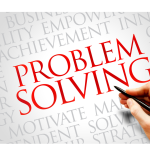Problem-solving is an inherent value every business venture covets for its employees.
And problem-solving skills are a value recruiters and HR managers look out for during talent acquisition.
Irrespective of what you studied or how good you are in your field of expertise, acquiring distinct problem-solving skills is highly essential in contributing to a healthy work-life; both for you and your employer.
Problem-solving in the workplace is unlike solving our daily personal problems. It is subject to so many factors and processes.
For one, the decision you are making is never personal as opposed to those of your private life, and most times might end up becoming part of the processes or structures your organization may end up adopting.
Seeing how important problem-solving is to an organization, it is pertinent as an employee that you arm yourself with a detailed understanding of what problem-solving is in the workplace and how to go about it.
In this article, we will be breaking down what problem-solving in the workplace is, problem-solving strategies, the benefits of problem-solving, and how to improve problem-solving in the workplace.
Table of Contents
What is Problem-solving in the workplace?
Problem-solving in the workplace means solving problems that arise in the workplace.
A problem is defined as any occurrence or event or thing that hinders progress. It can be an abnormal event or a disturbance to something.
These might include the day-to-day challenges and issues encountered while carrying out your job responsibilities.
It could also be bigger changes that affect not just you, but the entire team or the whole department.
The extent of the problem determines the capacity you need to solve the problem.
A problem as little as not being on eye level figuratively speaking with your colleague might hinder or affect your level of productivity at your workplace. And you cannot just walk up to confront him or her.
Diplomacy is highly needed, and some due processes have to be followed to maintain a conducive working environment.
The due processes might involve creating a system of communication or brainstorming an idea on how to communicate and listen better with that particular colleague.
And you cannot properly achieve a great result if you don’t possess some problem-solving skills and understand how to go about it.
Having established that problem-solving in the workplace is a little different from problem-solving in our daily personal life; although problem-solving process can also be implemented in our personal lives too.
Let us look at a 4-step problem-solving strategy in the workplace and how to use them.
Problem-Solving Strategies in the Workplace
-
Identify and define the problem
Just like the design thinking process, the first step to finding a solution to any problem is identifying your problem and of course, defining the problem.
Identifying the problem is not pointing out the symptoms of the problems, but tracing the root cause of those symptoms.
When you have uncovered the root cause of the symptoms, you can then go ahead to define the problem.
Defining the problem involves expanding the problem; how far has it gotten to, who and who is affecting or will it affect in the future, and also understanding all the combining factors connected to the problem in one way or the other.
If this part is gotten correctly, solving the actual problem has been 50 percent solved.
-
Generate different solutions to the problem
After arming yourself with every possible data on the problem and what it entails, the next step is to use that information to generate solutions.
Brainstorming for solution ideas should not just be based on the surface problem. Idea generation should encompass every aspect of the problem definition.
This ensures the right and lasting solution to the problem is produced.
Read also: How to celebrate professional wins in the workplace.
-
Evaluate your solutions and choose the perfect fit for the problem
Generally, during brainstorming, you and your team would have come up with lots of ideas and solutions.
During this stage, each solution is scrutinized and evaluated in terms of the root causes of the problem, and terms of overall longevity.
The solution shouldn’t be a one-off thing, except if it is a high-risk urgent situation.
Also, the stakeholders and departments that would be most affected by the solution should be put into consideration.
-
Implement the best solution
Once your solutions have been narrowed down to 2 or 3, the next step is to implement them to further choose which solution is the best possible fit for the problem.
Now every idea looks good on paper and in theory. Putting the idea into practicality reveals a great deal if the said idea is feasible.
Your best two solutions should be implemented and feedback should be analyzed.
From the feedback, you’d know how both solutions fit into the problem and how your colleagues and stakeholders feel about it. Then a decision is made.
Read also: How to give and take constructive criticism in the workplace.
This four-step process might not be the norm. But it is the best strategy to use for effective and lasting problem-solving in the workplace.
Benefits of Problem-solving in the Workplace
Effective problem-solving in the workplace breeds so many benefits and advantages. Some of those benefits are listed below:
-
Improves employee performance and output
Effective problem-solving in the workplace means meeting deadlines and completing tasks on time.
It also means less headache for the team and better performance output.
This results in growth in all areas and also more ROI for employers who have problem-solving skills as a major prerequisite in their recruitment process.
-
Time management
Time management is a problem-solving skill on its own, and we can not emphasize the importance of being time conscious in our everyday life.
Effective problem-solving in the workplace ensures you maximize your time efficiently for better performance and also for a healthy work-life balance.
Bringing your work headache home and brooding over an issue that would have been sorted with the right skills, is not healthy for you mentally and otherwise.
-
Risk management
Problem-solving in the workplace reduces the impact of disasters and epic failures, while also promoting a quick comeback and recovery in the event of a disaster attack.
Exhibiting problem-solving skills also gives you better confidence to do your job, as you are always ready to solve issues, and you are proactive enough to manage your risks.
Read also: 8 signs you’re in a toxic workplace.
-
Makes the job easier and faster
Imagine if you and all your teammates possess problem-solving skills, you’d bounce out of bed every morning and whistle all the way to work.
This is because you are happy to do your job. It is easier when everyone is innovative.
Tasks are achieved faster, you beat deadlines and the job just flows smoothly.
Judging from the above-listed problem-solving skills, you understand that working with someone that possesses more than 50% of those skills is a good idea.
-
Promotes a healthy work environment
A working environment that does not have strong problems solving structures put in place will always experience animosity from its employees because they will feel used.
Someone is taking responsibility for the failures and bursting his/her behind to come up with solutions for the problem.
A work environment that is problem-solving-centered and oriented will always boast of a healthier and more defined working environment.
Join Insight.ng’s WhatsApp community to access resources and opportunities that will aid your career growth.
-
Improves cognitive learning
All the steps and stages involved in problem-solving in the workplace are mentally induced.
Engaging in such activities often will improve your cognitive learning, and arm you with great learning abilities that will make you very valuable not just to your organization but also to your relationships.
Skills for Problem-solving in the Workplace
To be able to understand the importance of problem-solving in the workplace, it is essential to first understand the broad skill set required.
Problem-solving person refers to someone that can come up with solutions for unexpected and complex situations within a very short time.
People with a great affinity for problem-solving, possess a combination of different skill sets, like creative thinking, critical thinking, and great communication skills.
They also have a keen eye and are very observant. As a result, they can identify problems immediately and brainstorm effective and lasting solutions to the problems.
Listed below are some skills you should possess to practice problem-solving in the workplace.
- Creative Thinking and Ability
- Reading and Research
- Risk Management
- Root Cause Analysis and Issue Tracking
- Collaboration and Communication skills
- Time Management
- Emotional Intelligence
- Analytical and Critical Thinking
- Attention to detail/ Active Listening
- Brainstorming
Conclusion
Problem-solving in the workplace equals a healthy work-life balance.
Typically effective problem-solving in the workplace produces confident, smarter, independent, and happier employees.
This should be the goal of every employee; to win both in the workplace and at home.
I hope this article has shed light on problem-solving in the workplace and will serve as a guide to us.
For more premium posts like this, subscribe to our newsletter.
About Author
- Content and technical writer with seasoned experience in storytelling, user research, client satisfaction, and customer relationship management.
Latest entries
 Business InsightsMarch 2, 2023Agile Project Management: Why it is Good for Your Business
Business InsightsMarch 2, 2023Agile Project Management: Why it is Good for Your Business CareerJanuary 15, 2023A Guide to Problem-solving in the Workplace
CareerJanuary 15, 2023A Guide to Problem-solving in the Workplace Business InsightsDecember 10, 2022How to Deliver Excellent Customer Service in Your Business
Business InsightsDecember 10, 2022How to Deliver Excellent Customer Service in Your Business Business InsightsNovember 11, 2022How to Write a Business Report: Definition, Format, and Samples
Business InsightsNovember 11, 2022How to Write a Business Report: Definition, Format, and Samples

